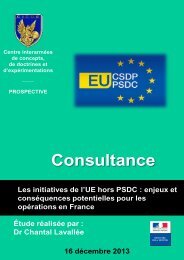Conference
science-research-bulletin-2013-conference
science-research-bulletin-2013-conference
Create successful ePaper yourself
Turn your PDF publications into a flip-book with our unique Google optimized e-Paper software.
EUROPEAN POLICE SCIENCE AND RESEARCH BULLETIN<br />
SPECIAL CONFERENCE EDITION<br />
1. SOME REMARKS CONCERNING<br />
THE DIFFERENCE BETWEEN<br />
VIOLENCE AND FORCE — OR<br />
— HOW TO LEARN THE USE OF<br />
COERCIVE POWER<br />
The nomenclature of official police culture, that<br />
embodies policing role models (amongst others),<br />
does not mention the relationship between<br />
‘violence and force’ in daily police-work. One<br />
consequence of banishing violence from the<br />
‘upper ranks’ of the police is that many police<br />
officers perceive that a significant part of their<br />
daily professional reality is not being mentioned.<br />
They, the ‘lower ranks’, need to secure their<br />
professional identity elsewhere, e.g. through<br />
creating their very own cop culture.<br />
Police education aims to avoid the use of physical<br />
power and ‘force’ as long as possible. This is what<br />
the major part of the training and education<br />
focuses on. On the other hand, recruits also<br />
need to develop a certain routine for inflicting<br />
injuries on somebody during training, i.e.<br />
practicing inflicting pain on people under certain<br />
circumstances without losing themselves in an<br />
emotional state of emergency (violent frenzy).<br />
However, the awareness of the complexity of<br />
such situations is only learned through direct<br />
experience when dealing with violent incidents<br />
and is hence not yet habituated by many young<br />
police officers when starting service. They<br />
need practical guidance through supervisors or<br />
experienced colleagues. The appropriate use<br />
of coercive power can be learnt by technical<br />
training; however, the actual experience of<br />
violence can only be found in real life situations.<br />
While police students learn on the one hand to<br />
use their coercive power very reluctantly, on the<br />
other, they perceive an increasing amount of<br />
violence being directed against them.<br />
2. VIOLENCE OF THE OTHERS<br />
An internal study on the prevalence of violence<br />
against officers of the Hamburg police in 2010<br />
(and also in 2011) came to the conclusion that<br />
there is neither a quantitative nor a qualitative<br />
increase in violent incidents encountered in<br />
everyday police work. Taken as a whole, neither<br />
the severity, nor the amount of incidents has<br />
increased dramatically. It is only the surrounding<br />
conditions that have changed (e.g. it is mentioned<br />
that there is an increase in the use of mobile<br />
phone cameras which leads to police actions<br />
immediately being accessible via the Internet and<br />
hence resulting in a general feeling of insecurity<br />
by police officers).<br />
Hence, even though an increase of violent<br />
incidents is not supported by statistics, it is an<br />
almost unchallenged public opinion that violence<br />
is on the rise. I believe that today’s complaints<br />
regarding the increase in violence are the<br />
result of an estrangement between the police<br />
and civil society. This divergence is connected<br />
to a loss of mutual appreciation, respect and<br />
communication between the so-called ‘problemgroups’<br />
and the police. The discourse on violence<br />
is merely a linguistic expression to call attention<br />
to the needs of police officers, but it has nothing<br />
to do with the actual experience of violence. I<br />
therefore also assume, that it is related to a<br />
policy that can roughly be summarised as an<br />
era of smart policing, starting in the late 1980s<br />
up to the very late 1990s (Behr 2006: 26-39). As<br />
different as these strategies may be, they all have<br />
in common that they are trying to improve the<br />
relationship between the police and the public<br />
(‘Bürgerpolizei’). This initiative reaches its climax<br />
with the reception and partial adoption of the<br />
Anglo-Saxon strategy of ‘community policing’<br />
which has led to multiple community crime<br />
prevention schemes and the increasing number<br />
of women in the police.<br />
Regarding the level of police culture, most<br />
national police forces and the formal federal<br />
border patrol are developing a new ‘Police<br />
Philosophy’ or ‘Police Guidelines’ (‘Polizeiliches<br />
Leitbild’) (Behr 2008: 242-249).<br />
A second major shift of police work can be found<br />
in the contact with victims. Approximately from<br />
the late 1980s onwards, the victim is no longer<br />
seen as soul-less piece of evidence used by the<br />
prosecution. Rather, victims are perceived as a<br />
subject with own interests, demanding police<br />
and judicial attention. Swiss criminologist Karl-<br />
Ludwig Kunz (2011: 361) already speaks of a<br />
trend leading towards a ‘victim-oriented society’<br />
(‘viktimäre Gesellschaft’) in which the victim or<br />
‘the loser’ instead of the winner becomes the new<br />
object of reference. Police departments, which<br />
operate crime prevention and victim protection<br />
schemes, have been extended or established. The<br />
newly introduced German Victim Protection Act<br />
from 2001 has had an important impact on the<br />
45





